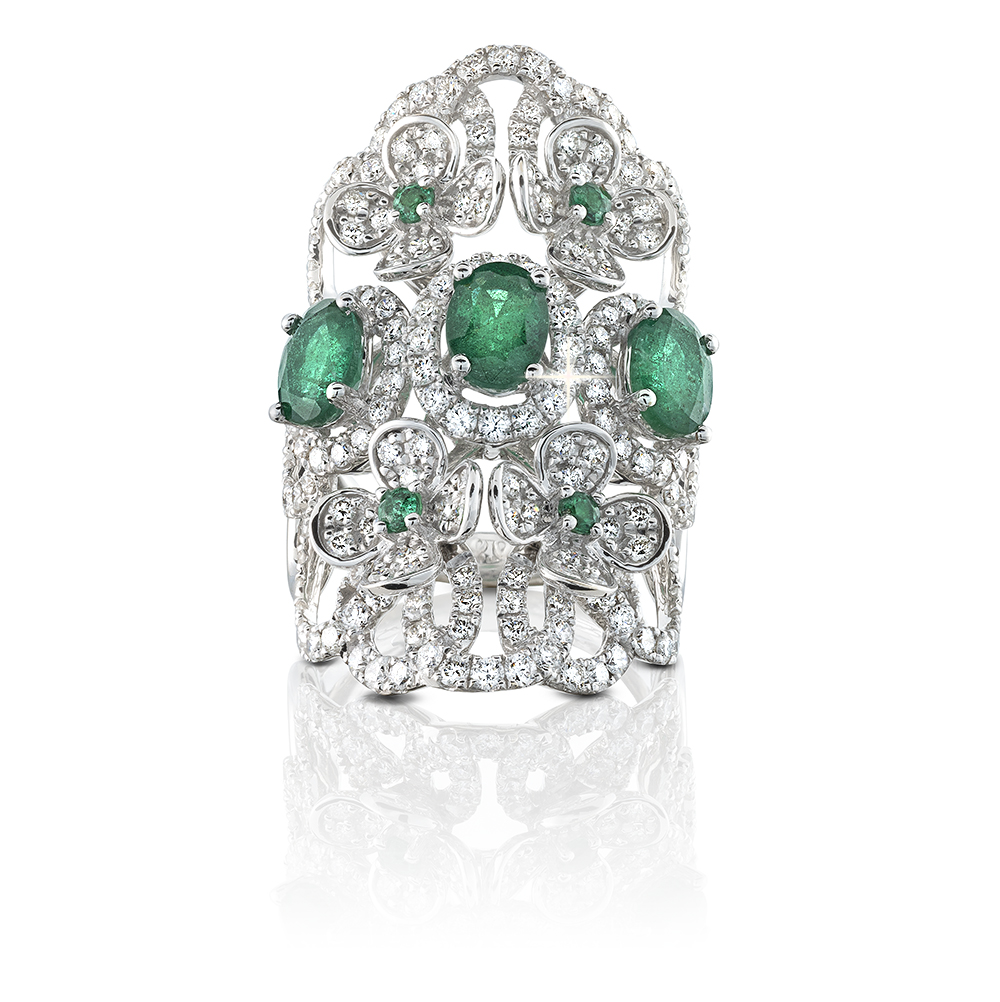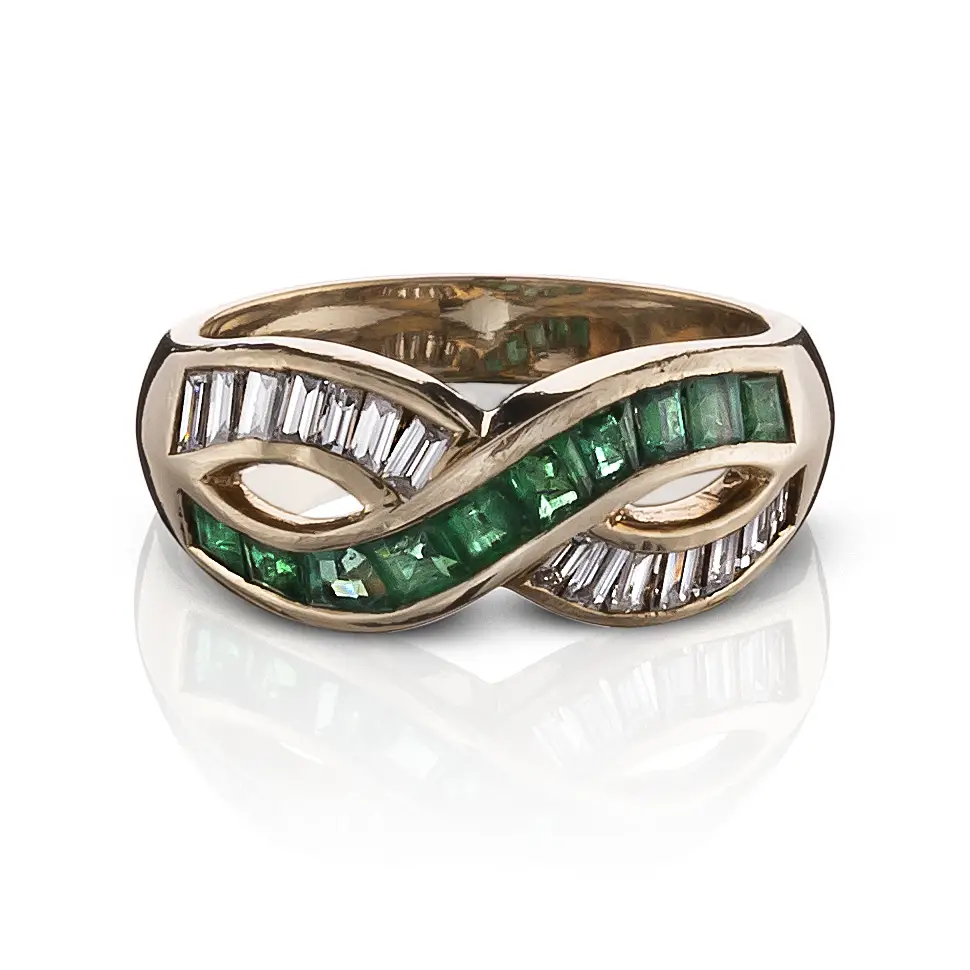If you’re in the market for an emerald, you’ll want to know how they are graded so that you can be sure to get the best quality stone for the amount of money you can afford to spend.
The four C’s – color, clarity, carat weight, and cut – play a role in determining an emerald’s grade.
In addition, when it comes to colored gemstones, there is also a thing called “translucency” which is an important grading criteria, and it is a lot like clarity would be when grading a diamond.
While a diamond is being graded for “color”…an emerald is similarly being graded for “tone” because there are different colors of green that range from light to dark and everything in between.
Let’s take a closer look at how these factors are considered when grading emeralds, and how they will affect the price you pay for one.
Table of Contents
What Are The Grades of an Emerald?
First of all, there are more categories and grades than what a gemstone dealer or jewelry store will be referring to when you are shopping for the final emerald product.
The other main grades before the emeralds are even in the hands of jewelry stores are:
- carving grade
- cabochon grade
- facet grade
These are grades that are applied to emeralds in their initial stage just after mining, and the main people who are interested in these grades are cutters, specimen collectors, geologists and labs.
We then move on to the kind of grading which will interest emerald dealers who will be selling to the jewelry stores and to the general public for jewelry grade emeralds.
| Grade | Description |
|---|---|
| Natural AAAA | These are the top 10% of gemstones or the best of the best in terms of quality. They are a rich green color and moderately to slightly included which means that their translucency exhibits high brilliance. These are usually found in very high end stores and are purchased by those with financial means. |
| Natural AAA | These gemstones fall into the top 20% to 30% of gemstones in terms of quality. These are a medium green and are also moderately included, but do not fall into being only slightly included. The translucency is still considered desirable although not excellent as in the highest grade. These gems are purchased by some of the top names of jewelry stores, although not necessarily the most expensive. |
| Natural AA | These gemstones fall into the top 50% to 75% of gemstones in terms of quality. They are dark green, heavily included and a bit opaque in translucency. They are compared to those found in Malls or small family jewelry stores who cannot afford to invest in the higher quality grades. |
The 4 C’s of Grading Emeralds
When the three grades above are referring to color and inclusions, that is not the only criteria that is of consideration.
Like diamonds and other colored gemstones, further clarification regarding quality is necessary because value is dependent on the details of each stone.
We refer to the standards of GIA (Gemological Institute of America) for explanation of how emeralds are graded, because it is their standard that is the highest and most recognized in the world.
How Color is Graded in Emeralds
In natural emeralds, color is evaluated by hue, tone and saturation.
Tone establishes the degree of darkness or lightness of green that is found in the gem. Just like rubies or sapphires, emeralds have a huge variety of green tones that range from very light to dark in terms of green shades.
| Color Grade | Description |
|---|---|
| Tone | An emerald that is rated high will have a tone that falls in the Medium to dark range, but that alone is not all to be considered because another important factor is if the hue is well saturated and evenly dispersed within the stone. |
| Hue | “Hue” refers to the type of green color an emerald has, for example, it could be referring to a bluish-green or yellowish-green. GIA is looking for emeralds that do not have color “zoning” where there is a mixture of hues. |
| Saturation | “Saturation” is what gives the color of an emerald its intensity and strength of color. It can range from a dull green to pure and vivid. If a stone has a dull saturation, the quality of it is lowered during grading. |
Because most emeralds on the market today come from Colombia, the hue will more likely present in a bluish-green color to pure green.
Emeralds that come from Brazil or Zambia will present with different hues, and this can help to identify origin.
But if an emerald that is a medium light color has vivid saturation, it will grade higher even though the color is not optimal.
This is why emeralds are graded by more than one category.
How Clarity is Grade in Emeralds
Emeralds have three Types of grades when it comes to clarity, whereas diamonds have at least 6.Because all emeralds are expected to have inclusions, they are not given such a heavy weight in grading as diamonds are.
The clarity is graded thus:
- Type 1: These are typically inclusion free or almost inclusion free. These are so rare that you would only “expect” to find them in emeralds that have been lab grown, but even then, some inclusions would be found under a microscope.
- Type 2: These are “usually” included, but not severely.
- Type 3: These are almost always included, some severely.
It is perhaps the vagueness of the three types of clarity grades that causes emeralds and other colored gemstones to have their value more dependent on translucency rather on inclusion content.
The spread of opinion is very wide on which grade to classify an emerald since most of them fall somewhere between type 2 and type 3.
How Carat Weight is Graded in Emeralds
Naturally, the carat weight is going to be the primary factor when decisions are being made to apply a monetary value on an emerald just as it would be for all other gemstones.
However, a small carat weight for a highly vivid stone would value higher than large carat weight for a stone which is dull.
This follows for any stone.
The larger the vivid stone, the higher the price.
Some emeralds are huge, weighing in at 50 or more carats, but they are opaque and their color saturation is poor. These may be fine for carving, but they will not be able to have much monetary value regardless of carat weight.
How Cut is Graded in Emeralds
Strangely, GIA does not grade cut in emeralds.
The average shape of an emerald is an “emerald cut” that is, it is a step cut of rectangular shape. GIA considers those types of cuts to be “fancy” and will mention the shape without going into how well the stone was cut.
Even though a badly cut gemstone can have its value downgraded by sloppy cutting, GIA grades for brilliance instead. The value of a stone will be given by the jewelry store or dealers, never by GIA.
FAQ’s About Grading Emeralds
Which emerald is best?
The best emerald is going to be the most expensive and the least seen.
If you want an emerald that has a high monetary value, then you will want one with vivid saturation, even if it is small in size.
However, if you are in the market for an emerald, then you should determine what qualities you want to see and not worry so much about having the best.
If you want a nice medium green that is not jam packed with dark inclusions and poor color saturation and zoning, then hold out for that type of stone.
A jewelry store should be able to procure the stone you want if you are a little patient.
What is the best cut for emerald?
Emeralds seem to show off their best self with the emerald shape cut rather than a round shape or a marquise shape. Following that, emeralds also look great in a radiant cut as well as a cushion cut.
Do emeralds chip easily?
Emeralds are notorious for chipping and cracking because they are a super soft gemstone. These stones are full of inclusions that can make them weaker than most stones.
Even in the face of all these inclusions, or even the lack of them, emeralds are best worn as earrings or pendants to avoid bashing and chipping.
What is the rarest emerald?
The rarest emerald is called the Trapiche emerald.
It has a pattern that looks like the outside of a striped watermelon in that it has dark stripes in combination with green in between each stripe. It is said to look like a wagon wheel too.
Because of the Lutite that is deposited during formation, the emerald ends up with six “axis” that are very distinct.
These are found in Columbia at the Muzo mine.
Final Thoughts
When considering buying an emerald, be sure to find out if it is an earth mined gemstone or a lab grown one if it is particularly clear (translucent) and a perfect green color.
You have the right to know if you are getting an expensive stone due to its natural earth grown origins or if you are getting one that has been grown faster in the lab.
Unfortunately, there is always going to be a stigma regarding gemstones that are grown in a lab even though they are identical to the ones grown longer from the earth.
Get everything in writing and make sure to take note of the types of inclusions that your stone has so that you will know if it renders it more fragile than others.



